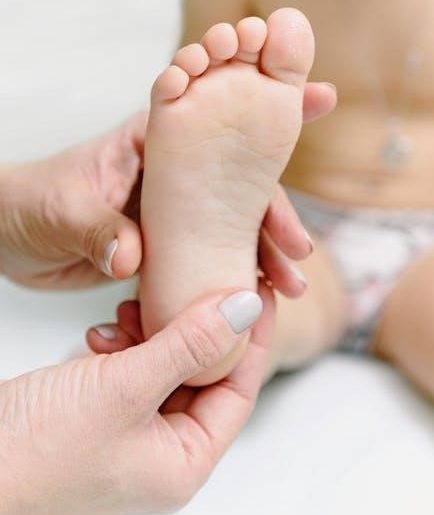A foot massage is a therapeutic practice offering relaxation‚ stress relief‚ and improved circulation. It promotes overall well-being and can be enjoyed by anyone‚ either self-administered or done by others. This holistic therapy is easily accessible and widely popular for its numerous health benefits.
1.1 Benefits of Foot Massage
A foot massage offers numerous benefits‚ including stress relief‚ improved circulation‚ and muscle tension reduction. It helps soothe tired feet‚ enhances relaxation‚ and promotes overall well-being. Regular massages can reduce pain‚ alleviate stiffness‚ and even improve sleep quality. By targeting specific areas‚ foot massage can also provide relief from aches and pains‚ making it a holistic therapy for both physical and mental health. Its accessibility and effectiveness make it a popular choice for self-care and wellness routines.
1.2 Importance of Foot Health
Foot health is essential for overall well-being‚ as feet bear the body’s weight and facilitate movement. Neglecting foot care can lead to discomfort‚ misalignment‚ or even injuries. Regular foot massages and proper care can prevent issues like bunions‚ calluses‚ and plantar fasciitis. Healthy feet also improve balance‚ posture‚ and mobility‚ ensuring a better quality of life. By prioritizing foot health‚ individuals can maintain optimal physical function and prevent potential complications that may arise from poor foot conditions or neglect.
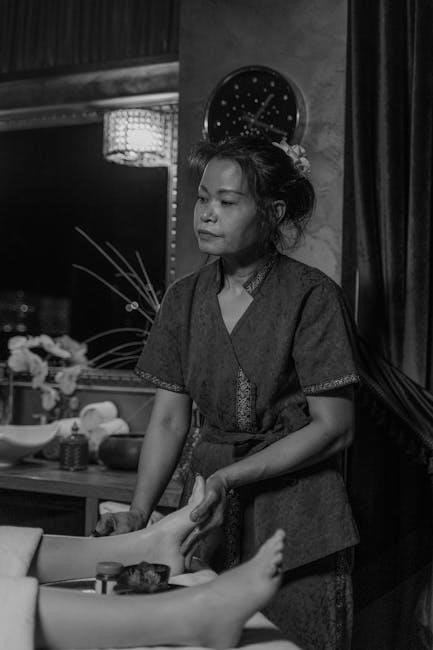
Preparation for a Foot Massage
Preparation for a foot massage involves creating a comfortable environment‚ selecting suitable oils or lotions‚ and positioning the body to ensure relaxation and accessibility.
2.1 Choosing the Right Oils or Lotions
Choosing the right oils or lotions is essential for a smooth and effective foot massage. Opt for products with moisturizing properties to soften the skin and reduce friction. Popular options include coconut oil‚ jojoba oil‚ or unscented lotions‚ which are gentle and non-irritating. Warming the oil or lotion in your hands before application enhances relaxation and improves circulation. Avoid using thick creams that may hinder techniques like gliding strokes or reflexology points. The right choice ensures a soothing and rejuvenating experience for the feet.
2.2 Setting Up a Comfortable Environment
Creating a comfortable environment is crucial for an effective foot massage. Start by ensuring the room is warm and quiet‚ with soft lighting to promote relaxation. Place a mattress or cushion on the floor for the person to lie down‚ with folded towels under their knees and ankles for support. Keep a bowl of warm water nearby for soaking feet‚ and have oils or lotions within reach. A calming ambiance‚ such as soothing music‚ can enhance the experience and help the person unwind.
2.4 Positioning the Body for Optimal Comfort
Proper body positioning is essential for a comfortable foot massage. The person should sit or lie in a way that allows easy access to their feet. If sitting‚ place a footrest or cushion under their feet to align the body naturally. If lying down‚ use pillows to support the lower back and knees. Ensure the feet are at a comfortable height‚ slightly elevated to improve circulation. This positioning reduces strain and promotes relaxation during the massage session.
Basic Foot Massage Techniques
Basic techniques include gliding strokes‚ firm strokes‚ circular motions‚ and gentle pulling. These methods promote relaxation‚ relieve tension‚ and improve circulation‚ forming the foundation of effective foot massage.
3.1 Gliding Strokes for Relaxation
Gliding strokes are long‚ smooth movements that promote relaxation and improve circulation. Start with light pressure‚ using massage oil or lotion to reduce friction. Stroke from the heel to the toes‚ then along the arch and top of the foot. Repeat gently‚ gradually increasing pressure if needed. This technique helps calm tense muscles‚ preparing the feet for deeper massage work. Focus on rhythm and consistency to create a soothing experience.
3.2 Firm Strokes for Tension Release
Firm strokes are essential for releasing tension in the feet. Using the palms or fingers‚ apply moderate to firm pressure‚ moving from the heel to the toes. Focus on the arch and plantar fascia‚ where tension often builds. Vary pressure based on comfort and specific areas of tightness. This technique helps break down adhesions and relaxes overworked muscles‚ enhancing flexibility and reducing stiffness. Communication is key to ensure the pressure is therapeutic‚ not painful.
3.3 Circular Motions for Muscle Relief
Circular motions are a soothing technique for relieving muscle tension. Using the fingertips or knuckles‚ apply gentle to firm pressure in circular patterns across the foot. Focus on areas like the arch‚ heel‚ and ball of the foot‚ where muscles often tighten. Vary the size and pressure of the circles based on the individual’s comfort. This method promotes blood flow‚ relaxes tight muscles‚ and helps release knots‚ leaving the feet feeling refreshed and rejuvenated with improved flexibility and reduced discomfort.
3.4 Gentle Pulling Techniques
Gentle pulling techniques involve lightly stretching the toes and foot muscles to enhance flexibility and relieve stiffness. Using the thumbs‚ gently pull each toe away from the foot and hold for a few seconds before releasing. This method helps elongate the muscles‚ improve circulation‚ and reduce tension in the feet. It’s especially effective for tight arches or toe joints. Work slowly and gently to avoid discomfort‚ ensuring a soothing and rejuvenating experience for the recipient.
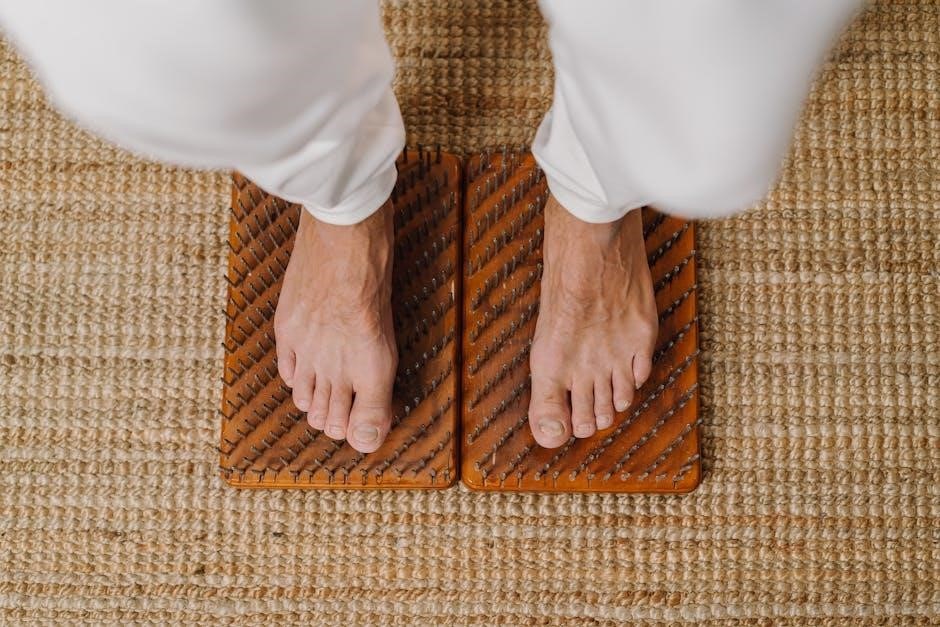
Advanced Foot Massage Techniques
Advanced techniques involve deep tissue work‚ specialized strokes‚ and precise pressure to target chronic pain and tension. These methods require skill and practice for optimal results.
4.1 Toe Bends and Rotations
Toe bends and rotations target the smaller muscles and joints‚ enhancing flexibility and relieving tension. Gently hold the toes and bend them forward and backward‚ then rotate each toe in circular motions. This helps loosen tight muscles‚ improve joint mobility‚ and reduce stiffness. Use massage oil for smoother movements and apply gentle pressure to avoid discomfort. Start slowly‚ increasing tempo as muscles relax. This technique is especially beneficial for individuals with toe or foot strain.
4.2 Knuckle Work for Deep Tissue Relief
Knuckle work involves using the knuckles or fists to apply deep pressure‚ targeting thick tissue layers in the feet. Focus on areas like the arch and heel‚ where tension often builds. Use slow‚ deliberate strokes or circular motions to release tight muscles and knots. This technique improves blood flow and breaks down adhesions‚ providing lasting relief. Be cautious with pressure to avoid discomfort‚ and adjust based on the recipient’s sensitivity for optimal results.
4.3 Sweeping Motions Between Bones
Sweeping motions between bones target the spaces between metatarsals‚ relieving tension and improving flexibility. Use your thumbs or fingers to glide smoothly along these areas‚ applying gentle yet firm pressure. This technique helps break up adhesions and enhances joint mobility. Focus on the arch and ball of the foot‚ where stress often accumulates. Regular practice can lead to better foot alignment and reduced discomfort during daily activities‚ promoting overall foot well-being.
Foot Reflexology Basics
Foot reflexology involves applying pressure to specific zones on the feet‚ corresponding to organs and systems. It aims to balance energy‚ enhance well-being‚ and complement health treatments.
5.1 Understanding Reflexology Points
Reflexology points are specific areas on the feet linked to organs‚ glands‚ and body systems. Each point corresponds to a particular part‚ such as the solar plexus or lungs. By applying gentle pressure‚ these points stimulate energy flow‚ promoting balance and well-being. Mapping these zones helps practitioners target areas for relief. Regular stimulation can enhance circulation‚ reduce stress‚ and improve overall health. Understanding these points is key to effective reflexology practice‚ making it a valuable complement to foot massage techniques.
5.2 Applying Pressure to Key Areas
Applying pressure to reflexology points involves using gentle‚ firm strokes or circular motions with the thumbs or fingers. Focus on areas corresponding to specific organs‚ such as the ball of the foot for the head or the arch for the spine. Pressure should be adjusted to individual comfort‚ avoiding pain. Techniques like knuckling or pressing tools can enhance effectiveness. Regular practice promotes energy flow‚ relieving tension and improving overall well-being. Proper pressure application is essential for maximizing benefits and ensuring a relaxing experience.
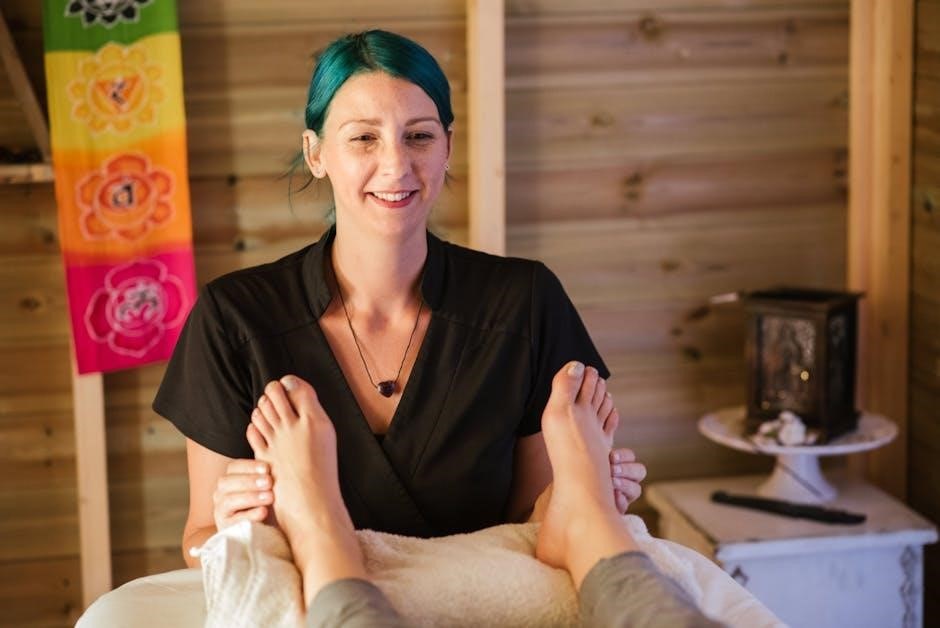
Self-Massage Techniques
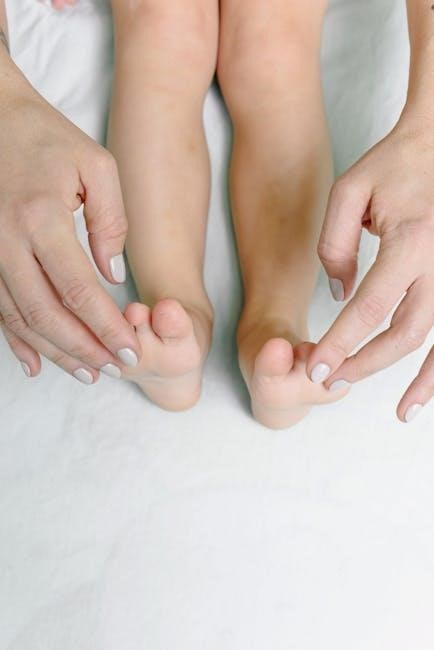
Self-massage involves using tools like rollers or manual techniques to relieve tension. Roll the soles‚ press with thumbs‚ or use fingers for targeted strokes. Regular self-massage enhances flexibility and relaxation‚ making it a convenient‚ cost-effective way to maintain foot health and overall well-being.
6.1 Using Tools for Self-Massage
Using tools like foam rollers‚ massage balls‚ or electric foot rollers can enhance self-massage effectiveness. Rollers target arches and soles‚ while massage balls provide deep pressure. Tools like wooden rollers or textured surfaces offer varying intensities. Electric rollers add vibration for muscle relaxation. These tools allow precise control‚ making it easier to relieve tension without assistance. Regular use improves circulation and reduces stiffness‚ ensuring feet stay healthy and energized. Always clean tools for hygiene.
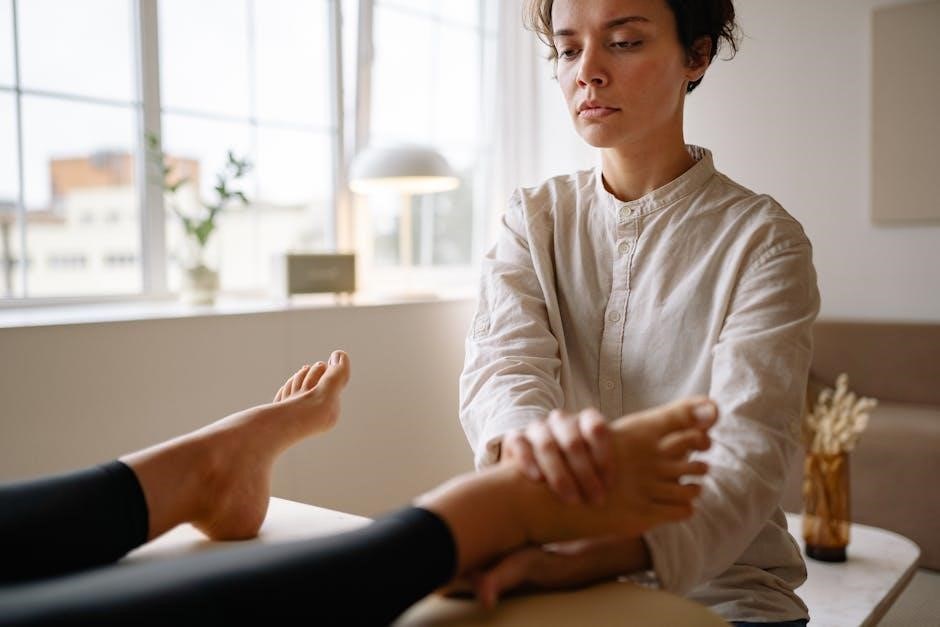
Benefits of Regular Foot Massage
Regular foot massage improves circulation‚ reduces muscle tension‚ enhances relaxation‚ and promotes better sleep. It also alleviates foot pain and boosts overall well-being and energy levels.
7.1 Improved Circulation
Foot massage enhances blood flow‚ improving circulation by stimulating blood vessels and promoting oxygen delivery to cells. Regular sessions reduce swelling‚ ease cold feet‚ and support overall cardiovascular health.
7.2 Reduced Muscle Tension
Foot massage effectively reduces muscle tension by targeting tight areas and promoting relaxation. Techniques like gliding strokes and firm pressure help break down adhesions in muscle fibers‚ releasing stored lactic acid. This relief minimizes stiffness and discomfort‚ especially in the arches and soles. Regular massage can prevent chronic tension‚ improving flexibility and reducing the risk of muscle-related pain or injuries‚ while enhancing overall mobility and comfort.
7.3 Enhanced Relaxation and Sleep
Foot massage promotes deep relaxation by calming the nervous system and soothing tight muscles. The gentle pressure and rhythmic strokes help reduce stress hormones‚ fostering a sense of tranquility. Regular sessions can improve sleep quality by easing tension and promoting a restful state. Many find that a pre-bedtime foot massage enhances their ability to fall asleep and stay asleep‚ leading to better overall well-being and energy levels the next day. This makes it a natural remedy for insomnia and restlessness.

Health Considerations
Foot massage can aid overall well-being but may not be suitable for everyone. Conditions like diabetes‚ poor circulation‚ or open wounds require caution. Always consult a healthcare professional before starting a foot massage regimen to ensure safety and effectiveness. This ensures personalized advice and prevents potential complications‚ making it a safe and beneficial practice for most individuals. Proper precautions can maximize its therapeutic benefits while minimizing risks.
8.1 Conditions That May Require Caution
Foot massage may not be suitable for everyone. Conditions like diabetes‚ neuropathy‚ or poor circulation require caution. Open wounds‚ infections‚ or recent injuries should be avoided. Severe arthritis or gout may also need gentle approaches. Always consult a healthcare professional before starting a foot massage regimen‚ especially if you have chronic health issues. This ensures safety and effectiveness‚ making it a beneficial practice for those with proper precautions in place.

Common Mistakes to Avoid
Common mistakes during foot massages include applying too much pressure‚ rushing the process‚ and neglecting proper preparation. Using incorrect techniques can lead to discomfort or injury. Awareness and careful execution are key to a safe and effective experience.
9.1 Overly Aggressive Techniques
Using overly aggressive techniques during a foot massage can cause discomfort‚ bruising‚ or even injury. Applying too much pressure or kneading too vigorously can strain muscles and ligaments. It’s essential to use gentle‚ controlled movements‚ especially for sensitive areas. Communicating with the person receiving the massage helps ensure pressure levels are appropriate. Starting with light strokes and gradually increasing intensity‚ if needed‚ is a safer approach to avoid causing harm.
9.2 Insufficient Preparation
Insufficient preparation can lead to an uncomfortable or ineffective foot massage experience. Failing to clean or moisturize the feet may cause dryness or rough patches‚ making techniques less smooth. Neglecting to warm the feet or prepare the environment can reduce relaxation benefits. Using inadequate tools or oils may also hinder the massage’s effectiveness. Proper preparation ensures a more enjoyable and beneficial session for both the giver and receiver‚ addressing potential issues before they arise.
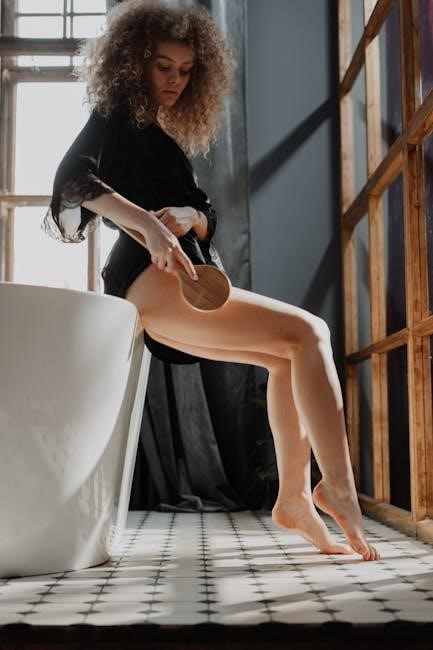
When to Avoid Foot Massage
Foot massage should be avoided in cases of acute injuries‚ infections‚ severe swelling‚ or open wounds to prevent further discomfort or complications.
10.1 Acute Injuries or Infections
Foot massage should be avoided if there are acute injuries‚ such as fractures‚ sprains‚ or severe bruises‚ as it may worsen pain or delay healing. Infections like fungal infections‚ open wounds‚ or cellulitis require medical attention and should not be massaged to prevent spreading the infection. Massaging injured or infected areas can increase inflammation and discomfort. It’s essential to wait until the injury or infection has fully healed before resuming foot massage. Always consult a healthcare professional if unsure.
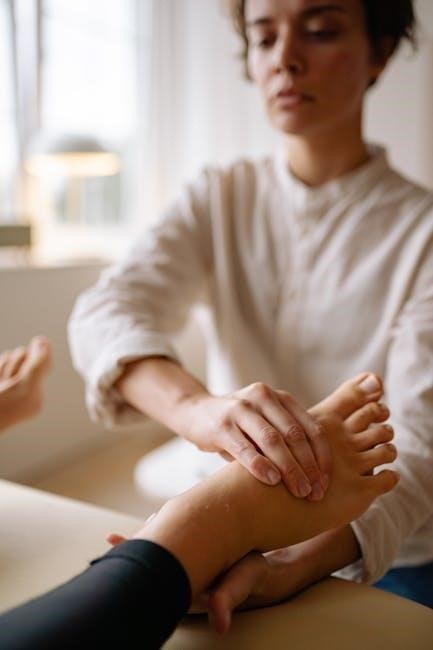
Tips for Enhancing the Experience
Combine foot massage with soothing music‚ warm towels‚ or aromatic oils to create a relaxing atmosphere. Use gentle pressure and focus on key areas for maximum comfort and relief.
11.1 Warming Up the Feet
Begin by gently warming the feet to enhance relaxation and circulation. Soak feet in warm water with Epsom salts or essential oils for 10–15 minutes. Alternatively‚ wrap feet in a warm‚ damp towel or use a heating pad. Gentle foot exercises‚ such as toe wiggles and ankle rotations‚ can also prepare the muscles for massage. Warming up reduces muscle tension and makes the massage more effective‚ ensuring a deeper sense of comfort and relief.
11.2 Using Comfortable Surfaces
Ensure the massage surface is comfortable and supportive. A padded massage table or a soft cushion on the floor works well. Adjust the height to avoid straining your back. Use a clean‚ soft towel or sheet to create a hygienic and cozy environment. Consider adding a non-slip mat for stability. A comfortable surface enhances relaxation‚ allowing the recipient to fully enjoy the massage experience without distractions or discomfort.
Incorporating foot massage into your routine can greatly enhance overall well-being. By improving circulation‚ reducing tension‚ and promoting relaxation‚ it offers numerous benefits for both body and mind. Whether performed professionally or as a self-care practice‚ foot massage is a simple yet powerful way to nurture health. Regular practice can lead to lasting positive effects‚ making it a valuable addition to any wellness journey. Embrace this holistic practice and enjoy the transformative results it provides.
